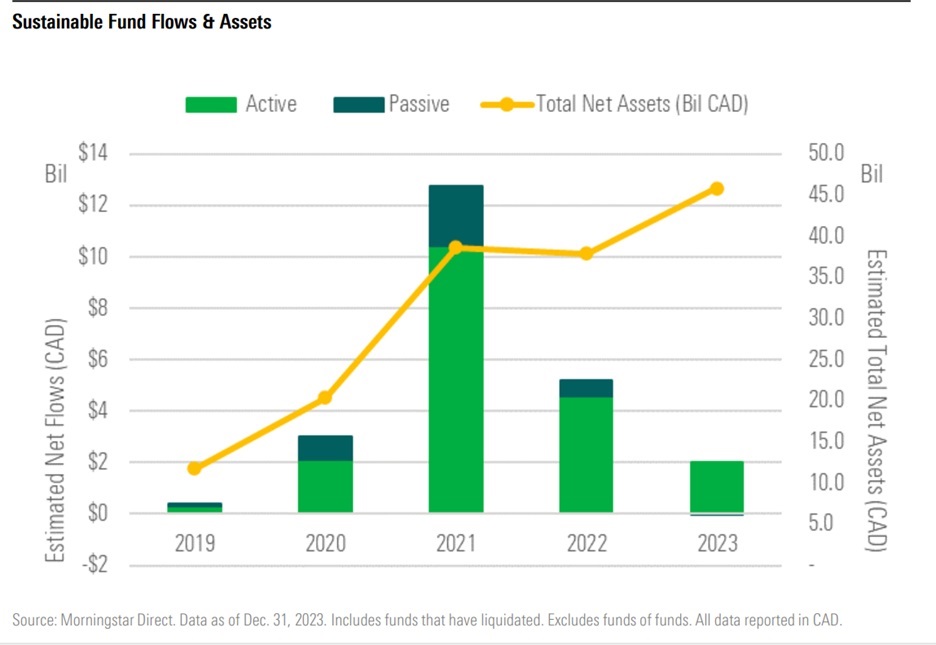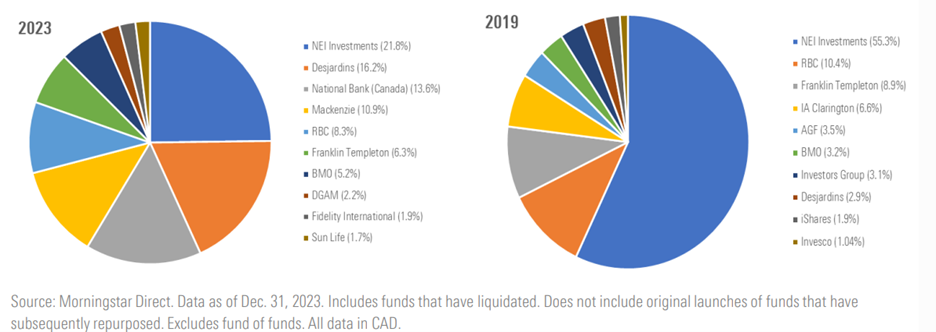
Our latest Canadian Sustainable Funds Landscape confirms that Canadian interest in responsible investing is here to stay! Unlike the overall market, which saw net outflows in 2023, Canadian sustainable funds saw net inflows, albeit at a slower pace than in 2021 and 2022.
Likely contributing to the ESG inflows, the launch of the Responsible Investment Identification Framework in February 2023 by the Canadian Investment Funds Standards Committee (CIFSC) guides investors to better align their preferences with a specific responsible investment approach. And those who invested in 2023 were met with a rebound in performance.
Some of the highlights from our report include:
1) Sustainable Fund Flows Slowed but Remained Positive
Despite small outflows in the fourth quarter of 2023, Canadian-domiciled sustainable funds registered over C$2 billion in net new assets in 2023 and the space grew to over C$45 billion total assets. This is a stark contrast to our southern neighbours as US investors pulled more than US$13 billion from sustainable funds last year. National Bank Investments stood out as clear winners here with over 57% of new assets going into their sustainable funds. NBI Sustainable Canadian Bond ETF NSCB dominated and brought in more than twice the amount of new money than any other fund.

Actively managed funds continue to be the most popular choice for investors and asset managers – 73 of the 78 funds launched in 2023 use active management. That said, while historically sustainable equity funds have been the go-to for investors’ deposits, this year sustainable fixed-income funds took the crown, a trend seen across conventional funds as well likely due to more favourable bond yields.
2) Sustainable Fund Performance Rebounded in 2023
Sustainable fund performance bucked its trend of historically weaker results relative to conventional peers in 2023. Over 50% of sustainable funds landed in the top half of their respective categories. Sustainable Canadian equity funds (including funds in Canadian-focused equity categories) had the strongest result with 46% of funds landing in the top quartile of their categories. Desjardins RI Canada Multifactor Net Zero Emissions Pathway ETF DRFC topped the charts with a 16.4% gain that beat 93% of its peers and benchmark by more than four percentage points.

Sustainable Canadian equity funds were well positioned going into the year, with two-thirds showing an overweight to technology – the top-performing sector in the index. Similarly, over 80% of funds had an underweight to the energy sector, where middling results weighed on the index.
3) Competition Heating Up Among Sustainable Fund Managers
Since 2019 we have seen the number of asset managers offering sustainable funds grow substantially and investors have a plethora of shops to choose from. Although still the largest sustainable fund provider, NEI Investment’s 2019 55% market share has been cut in half with Desjardins, National Bank and Mackenzie emerging as key competitors representing 16%, 14% and 11% respectively.

National Bank and Mackenzie also topped the list of shops receiving the most inflows in 2023. Their combined net inflows represent over 76% of all sustainable fund inflows last year.
4) Sustainable Funds Continue to Deliver Low ESG Risk
Using Morningstar’s Sustainability Rating (also known as the Morningstar Globe Rating) to assess the exposure of ESG risks in sustainable funds relative to their respective global categories, it is clear sustainable funds have, on average, succeeded in providing investors less exposure to these risks than conventional peers. Over 70% of sustainable funds earn four or five globes where the higher the globe rating indicates a lower overall exposure to ESG risks relative to peers.





:quality(80)/cloudfront-us-east-1.images.arcpublishing.com/morningstar/6ZMXY4RCRNEADPDWYQVTTWALWM.jpg)














